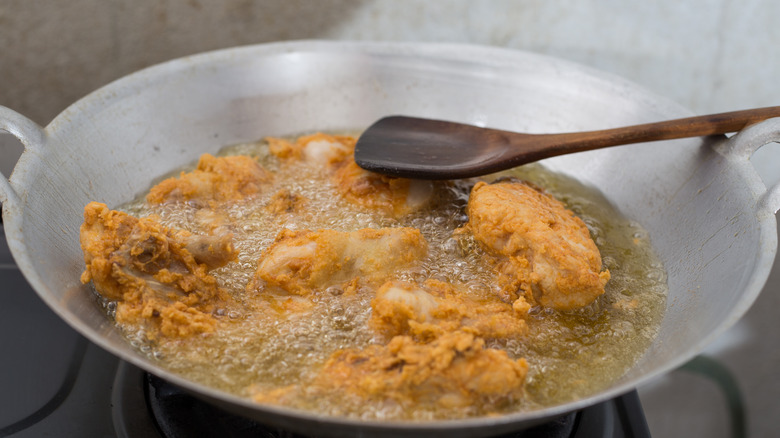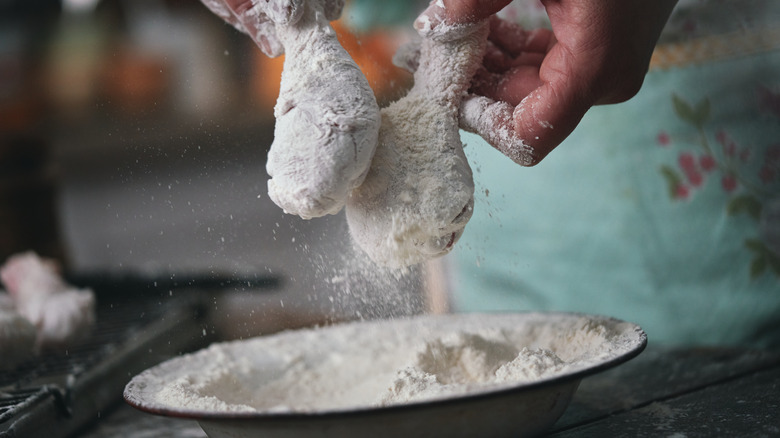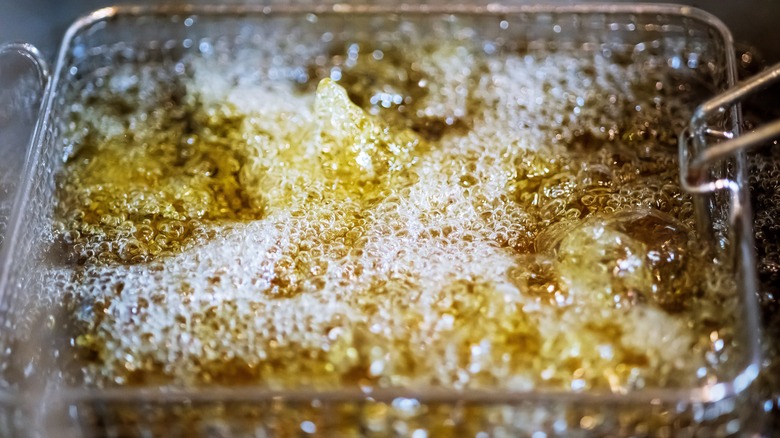Easily Test The Temperature Of Your Cooking Oil With A Utensil Hack
Frying food at home can be a little intimidating to those who aren't seasoned pros. At worst, it can be painful if you don't take the (very necessary) safety precautions; at best, it can be a metaphoric pain to get your oil temperature just right. Despite what you might think, you don't need fancy equipment to make deep-fried food at home. In fact, you don't even have to own a thermometer. Whether you're frying chicken or whipping up a batch of homemade donuts, you can be sure your frying oil is at the perfect temperature by simply sticking the end of a wooden spoon in your oil.
Wooden utensils have a high porosity, meaning they have little air pockets and are absorbent. They often retain water via washing and cooking, which means that when your fry oil is hot enough, you can stick the end of the spoon in the oil and tiny bubbles should appear around the spoon handle. Be mindful that if you don't wipe the oil off the spoon as soon as you remove it, the hot oil will be absorbed as it cools, filling the space where water and air once were trapped and potentially setting you up for a false negative for future spoon/oil tests.
Keep your cool, in a hot way
It's important that you adequately preheat your oil before putting anything in it to fry. Introducing food to the fryer before the oil has reached a proper temperature (usually between 325 and 375 degrees Fahrenheit) will result in soggy, heavy food. The flour dredge that tends to coat most pieces of fried food will absorb oil that isn't hot enough. If you drop the food into properly heated oil, it should sear the outer layer of the food while cooking throughout, as long as the temperature remains steady.
The only thing worse than frying oil that's too cold is oil that's too hot. If your oil temperature is too high, you run the risk of scorching the dredge (or the outer layer of your food), while the inside remains raw and uncooked. Oil that begins to smoke is surely too hot, and while different frying oils have different smoke points, know that any smoking is a no-go. This style of cooking is a balancing act and requires your presence. Whatever you do, never leave your fryer unattended.
Alternatives to the spoon method
The wooden spoon trick is an excellent way to test your oil if you don't have a thermometer on hand, but it shouldn't be your only tactic. If you're going to be regularly frying food at home, it's important to invest in a kitchen thermometer to make your experience easier and safer. Not all wooden spoons retain the correct porosity, and further, they can be damaged and dehydrated if used for this method regularly. Also — if you're unsure what condition your utensils are in, this can make the oil testing unreliable. Besides, a kitchen thermometer can be handy for plenty of other things, like testing the internal temperature of meat and making candy.
If you don't want to damage your wooden spoons or you simply don't own any, there are other ways to test your frying oil. Toss a popcorn kernel into the fryer; when it becomes a piece of popcorn you know your oil is hot enough to begin. When embarking on a frying journey, be deliberate, present, and unafraid: The process is simpler than it may seem, and the results are oh-so delicious.


